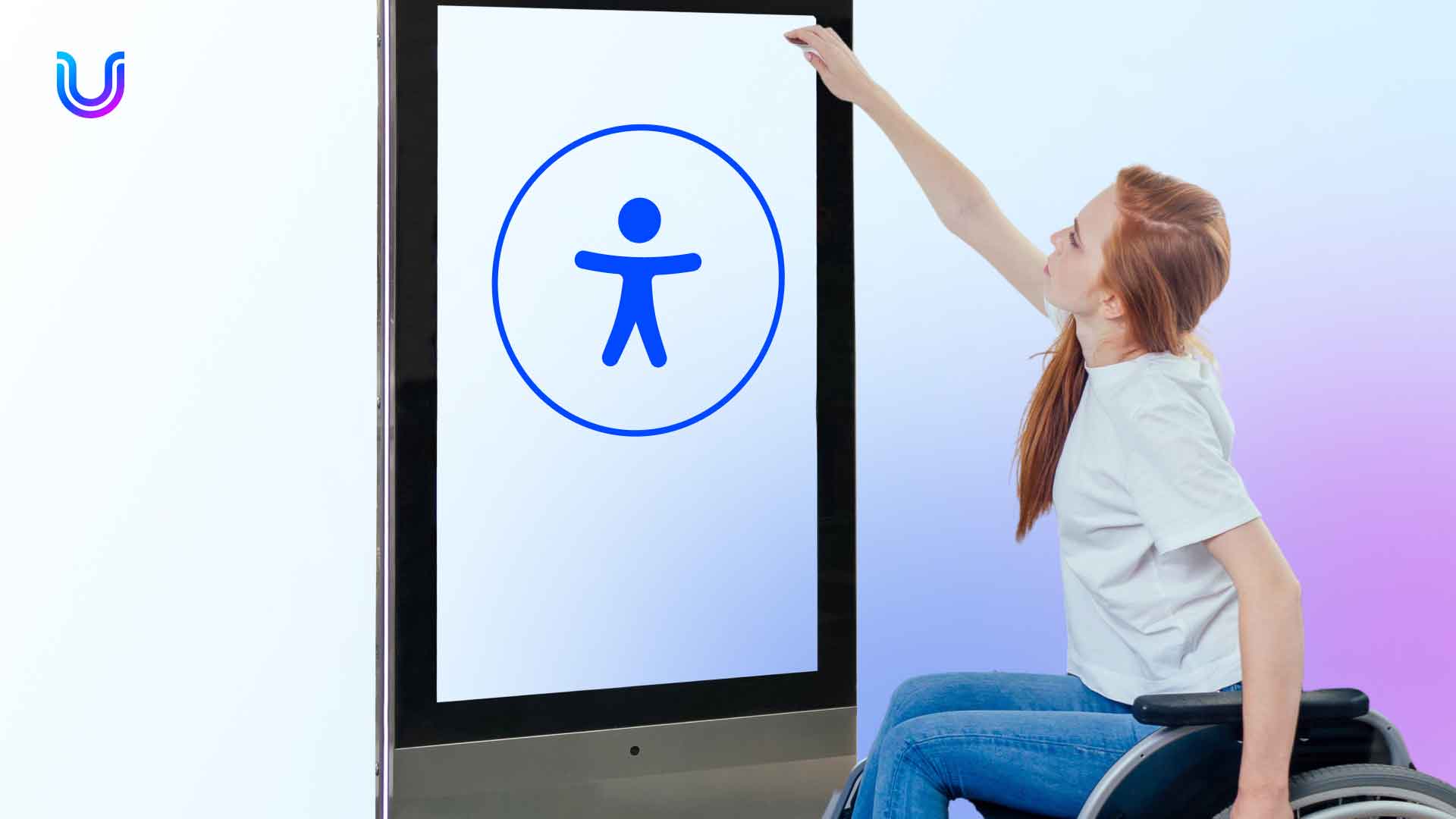How to design digital kiosks that everyone can access

In our digital-centric world, much of the conversation around accessibility centers on websites and mobile apps, but there’s an equally important but less discussed arena needing attention: digital kiosks. Commonly found in shopping malls, airports, and public squares, these standalone devices are engineered to streamline service delivery, offering quick access to information, reducing wait times, and enhancing user experience – all while being cost-effective by minimizing staffing needs and operating around the clock.
However, despite their intended convenience and efficiency, digital kiosks frequently overlook the needs of a significant portion of the population – people with disabilities. With an estimated 1.3 billion people worldwide living with a significant disability, many of these kiosks lack the inclusive design required to serve everyone, limiting their functionality and their reach.
In this blog, we’ll focus on kiosk design and the accessibility of these increasingly prevalent tools scrutinizing their role across various industries and questioning just how convenient they are for everyone.
What is digital kiosk accessibility?
Kiosk accessibility refers to designing kiosks in a way that all users, including those with disabilities, can use them effectively – and independently. The goal is to ensure that everyone has equal access to the information and services provided by these digital systems, regardless of physical ability, sensory impairments, or cognitive differences.
For a digital kiosk to be accessible, they must incorporate features such as adjustable height settings for wheelchair users, audio output for people with visual impairments, tactile buttons for users who cannot use touch screens, and clear, simple interfaces that help users with cognitive disabilities navigate the services more easily. These features should also comply with legal standards like the Americans with Disabilities Act (ADA) and embrace the principles of universal design, making the kiosk interactive and usable for the widest range of people possible.
What is an interactive kiosk?
It may be important to point out that the terms “digital kiosk” and “interactive kiosk” are used interchangeably, reflecting their common purpose to enhance user interaction through technology. Both are designed to be user-friendly, often featuring touch screens that allow users to navigate services and input information directly. This direct interaction is a key component, differentiating them from static displays or non-interactive digital signs. These touch screen kiosks can also be equipped with connectivity options that allow for real-time communication and updates, further enhancing their functionality and the user experience.
How do digital kiosks work?
At the heart of a kiosk is a computer that runs software applications, connected to the internet to access and update information in real time. Users interact with these systems through a touchscreen display, which simplifies tasks such as navigation and data entry.
A kiosk’s functionality extends through various peripherals, including scanners, printers, cameras, and card readers, enabling it to perform a wide range of tasks – from printing tickets and scanning codes at retail kiosks to accepting payments. Whether it’s helping tourists navigate a city or allowing moviegoers to skip the line, digital kiosks blend convenience with technology to serve users efficiently around the clock.
What are examples of digital kiosks?
We encounter digital kiosks in many of the sectors we interact with daily, often without even realizing it. Here are a few examples:
1. Airport check-in kiosks: These allow passengers to check in, print boarding passes, and even tag their luggage, helping to streamline airport logistics and reduce wait times.
2. Retail kiosks: Found in shopping malls and stores, these kiosks might help customers check product availability, locate items in the store, or even place orders for out-of-stock products to be shipped to their homes. Some shopping mall kiosks are able to leverage data analytics and artificial intelligence to offer personalized product recommendations shoppers’ preferences and past behaviors.
3. Ticketing kiosks: Commonly seen at movie theaters, train stations, and parking lots, these machines enable users to purchase or pick up tickets, often allowing them to bypass lines at the ticket counter.
4. Information kiosks: Located in museums, parks, and tourist spots, these provide interactive maps, event information, and historical facts, enhancing the visitor experience through engaging digital content.
5. Healthcare kiosks: Used in hospitals and clinics, these kiosks can manage patient check-in processes, gather preliminary health information, and even schedule follow-up appointments.
What are the requirements for kiosk accessibility?
When it comes to making kiosks accessible, there are a few key guidelines and requirements to keep in mind:
Height and reach: The kiosk should be positioned so that all interactive elements are within easy reach for both seated and standing users. The location, height, and operability of kiosks need to factor in people with disabilities too – including wheelchair users. How users get to and access the kiosk must meet The Americans with Disabilities Act (ADA) kiosk requirements.
Clear floor space: Provide enough clear space around the kiosk so that a person using a wheelchair can approach and use the kiosk comfortably. This usually means a space of at least 30 inches by 48 inches.
Clear and concise language: Use plain language and simple instructions on the kiosk interface. Avoid jargon to ensure easy comprehension.
Screen readability: Use high-contrast colors and large font sizes to ensure that text is easy to read. Screens should avoid glare, which can be a significant barrier for visibility.
Font size and contrast: Choose clear fonts with adjustable size options. Make sure there’s high color contrast between text and background for better visibility, especially for those with low vision and color blindness.
Text-to-speech and speech-to-text: Implement text to speech functionality to read out on-screen text for users with vision disabilities. Consider speech-to-text features to accommodate those who may have difficulty typing. Make sure these features also ensure the privacy of your users.
Alternative input methods: To diversify the interaction options on the kiosk, consider including touchscreens, buttons, and voice commands. For people with motor disabilities, add larger buttons or joystick controls. And for those who need non-visual options, tactile controls could be a great addition.
Audio output: Incorporate speech output or other auditory signals, especially in environments where visual interaction might be hindered. This feature should come with adjustable volume controls.
Error handling: Offer clear and helpful error messages at the time an error is made (not after trying to submit an error filled form) that guide users on how to correct their actions.
Adding these features helps digital kiosk developers align with accessibility law and guidelines while creating an inclusive environment that welcomes everyone to access essential services.
Kiosk accessibility: Inclusivity required by law
The European Accessibility Act (EAA) is set to revolutionize the inclusivity of kiosks and other touch-screen devices. According to Directive 2019/882, the Act mandates that all self-service terminals, including payment terminals, ATMs, ticketing machines, check-in machines, and interactive self-service terminals providing information, must be accessible to all users.
The key accessibility requirements are outlined in Annex 1 of the EAA Directive, with Annex 2 providing examples and solutions to meet these requirements. Manufacturers and service providers must ensure that their kiosks and touchscreens accommodate a wide range of disabilities, from visual and auditory impairments to mobility challenges. This approach ensures that digital kiosks can be used by everyone, promoting inclusivity and equal access to services.
Compliance with the EAA is required for all products placed on the market after June 28, 2025. Existing kiosks and touchscreens can remain in use for up to 20 years or until they need replacement, focusing the compliance efforts on new products.
This phased approach allows businesses to transition smoothly to more accessible solutions while enhancing the overall user experience for people with disabilities. With 135 million individuals in the EU living with disabilities who may encounter daily hurdles in accessing digital kiosks, the EAA’s new ruling is a positive step forward in addressing the digital divide.
How to test the accessibility of your digital kiosk
Be aware of the accessibility laws that pertain to your business, such as the European Accessibility Act and the ADA and start by engaging directly with the community it’s intended to serve. Incorporate a diverse group of users with disabilities in your prototype testing to capture genuine insights and feedback about your kiosk’s usability. This hands-on approach will help you identify potential barriers and areas for improvement early in the design process, so your kiosk meets the required standards and provides a seamless experience for all users.
It’s also important to rigorously test the kiosk’s compatibility with a variety of assistive technologies, such as screen readers and alternative input devices, to make these integrations seamless extensions of the user experience.
To build a digital kiosk that meets the highest standards of accessibility, undertake a comprehensive accessibility audit. This should be performed by seasoned professionals who can meticulously evaluate both the hardware and software components. Such an audit should align with stringent accessibility standards like the Americans with Disabilities Act (ADA) and Section 508, and adhere to the Web Content Accessibility Guidelines (WCAG). This will be a great way to bring your kiosk into the necessary compliance while establishing a high standard for inclusivity.
UserWay: for kiosks designed with accessibility in mind
Kiosk design should prioritize accessibility from the start, rather than treating it as a secondary feature. As a leader in making digital platforms user-friendly, UserWay understands that true inclusivity extends beyond websites and apps to include digital kiosks as well. By adopting UserWay’s accessibility tools and solutions, you can add accessibility to your digital kiosks, providing a seamless experience for users of all abilities. Reach out to a UserWay accessibility expert and let’s move you towards digital kiaosk compliance and accessibility today.
Common FAQs
What should an accessible digital kiosk display?
An accessible digital kiosk display should feature high-contrast colors and large, legible fonts to aid visibility. The interface should include simple, clear instructions and the option for audio output to assist users with visual impairments. It’s also beneficial to incorporate responsive touch technology that can be used easily by those with motor impairments, and alternative navigation options like voice commands or tactile keypads for users who cannot use a touchscreen effectively.
How do you make touch screen kiosks accessible?
To make touch screen kiosks accessible, incorporate features like audio guidance, tactile buttons, Braille labels, and adjustable screen heights to accommodate users with visual, auditory, or physical disabilities. Additionally, ensure that the user interface is simple and intuitive, with high-contrast visuals and large, easy-to-read fonts to assist those with visual impairments.
Are there legal requirements for making digital kiosks accessible?
Yes, there are legal requirements in many regions, including the Americans with Disabilities Act (ADA) in the United States and similar legislation in other countries. These laws mandate that public accommodations, including digital services offered through kiosks, must be accessible to people with disabilities. Non-compliance can lead to legal action and negative publicity. Ensuring kiosk accessibility is a moral imperative as much as it is a legal obligation.




Share